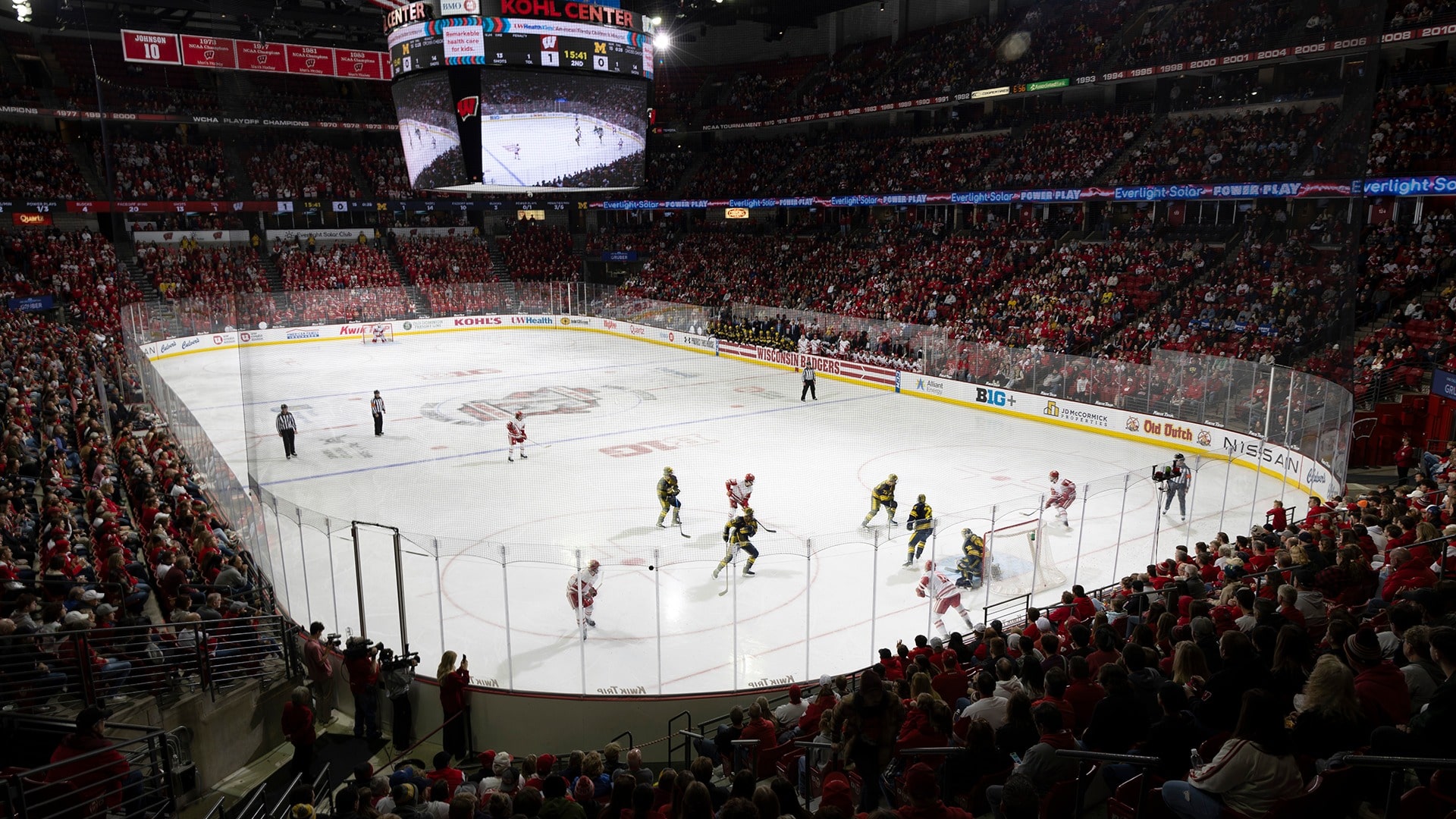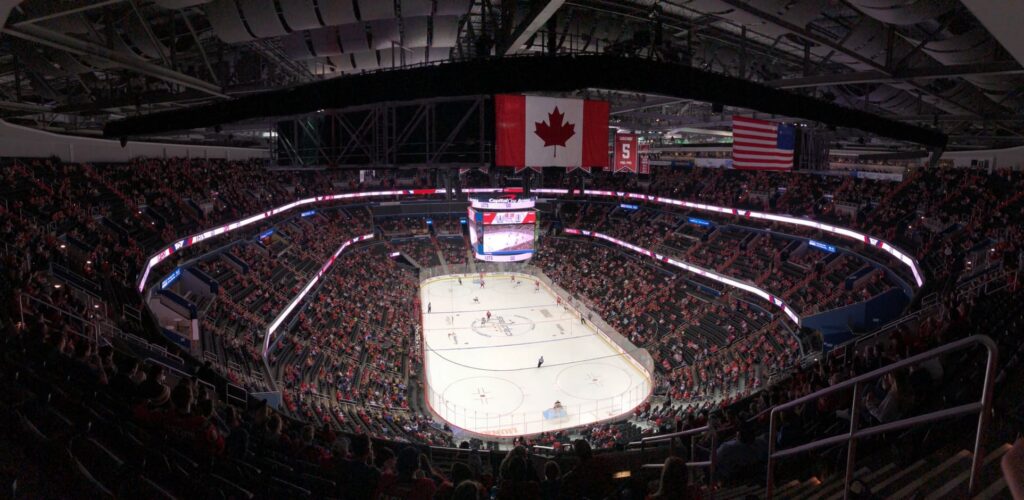How Big Are Ice Hockey Rinks: Unveiling the Icy Proportions

Ice hockey rinks are typically 200 feet long by 85 feet wide. The dimensions may vary slightly.
Ice hockey rinks are a crucial component of the game, providing the stage for thrilling matches and showcasing the talents of skilled players. The standard size of a rink is 200 feet long and 85 feet wide, offering ample space for high-paced action and strategic maneuvers.
The distinct layout of the rink, with its smooth ice surface and marked boundaries, creates an immersive experience for both players and spectators. Understanding the dimensions and layout of ice hockey rinks is essential for appreciating the sport’s dynamics and the skills required to excel on the icy battleground. So, let’s dive deeper into the intricacies of ice hockey rinks and explore what makes them an integral part of the game.
SIZE OF ICE HOCKEY RINKS
In the sport of ice hockey, the size of the rink plays a crucial role in the speed and flow of the game. The dimensions of an ice hockey rink greatly impact how the game is played, and different arenas may have slight variances in size. Understanding the standard dimensions and potential variances in size can provide insight into the unique playing conditions that each rink offers.
STANDARD DIMENSIONS
The standard dimensions of an ice hockey rink, as specified by the International Ice Hockey Federation (IIHF), are 61 meters (200 feet) in length and 30 meters (98.5 feet) in width. This uniform sizing allows for consistency in gameplay and ensures that players and teams can adapt to various rinks with minimal difficulty. The rectangular shape of the rink serves as the foundational space for the exhilarating competition that unfolds on the ice.
VARIANCES IN SIZE
Despite the standard dimensions established by the IIHF, there can be variances in the size of ice hockey rinks. In North America, the National Hockey League (NHL) uses rinks that are slightly smaller, with lengths ranging from 61 to 61.98 meters (200 to 204 feet) and widths from 25 to 25.6 meters (85 to 89 feet). These variations can lead to differences in gameplay, emphasizing the importance of adaptability for teams and players competing in diverse rink environments.

REGULATION ICE HOCKEY RINK SIZE
When it comes to ice hockey, the size of the rink plays a crucial role in the game. Understanding the regulation dimensions of an ice hockey rink is important for players and fans alike.
NHL AND INTERNATIONAL STANDARDS
The National Hockey League (NHL) and international competitions adhere to specific standards when it comes to ice hockey rink size.
KEY MEASUREMENTS
- Overall Size: An NHL ice hockey rink measures 200 feet in length and 85 feet in width.
- Goal Crease: The goal crease is a semicircle that extends 4.5 feet from the goal post into the rink.
- Faceoff Circles: The faceoff circles have a radius of 15 feet, located at each end of the rink.
- Blue Lines: The blue lines divide the rink into three zones and are each 12 inches in width.
- Goal Posts: The two goalposts in ice hockey are 4 feet tall and 6 feet wide.
- Neutral Zone: The neutral zone, between the two blue lines, is 50 feet in length.
FACTORS INFLUENCING RINK SIZE
Factors influencing rink size in ice hockey are crucial in shaping the dynamics of the game.
IMPACT OF RINK SIZE ON GAMEPLAY
- Rink size directly impacts player speed and strategy
- Smaller rinks lead to faster-paced, physical games
- Larger rinks promote skillful plays and teamwork
CULTURAL AND HISTORICAL CONTEXT
- North American rinks are typically larger than European rinks
- Historically, rink size varied based on available space
- Cultural preferences influence rink dimensions worldwide
COMPARISON WITH OTHER SPORTS ARENAS
Ice hockey rinks are unique in their size and dimensions, especially when compared to other sports arenas. Understanding the differences in dimensions, as well as the purpose and impact of these rinks, can provide insight into the dynamic nature of ice hockey as a sport.
DIFFERENCES IN DIMENSIONS
When comparing ice hockey rinks to other sports arenas, the most striking difference lies in their dimensions. The average size of an ice hockey rink is approximately 200 feet by 85 feet, while arenas for other sports such as basketball and soccer have notably different dimensions. For example, a standard basketball court is roughly 94 feet long and 50 feet wide, and a soccer field can vary from 100 yards by 50 yards to 130 yards by 100 yards.
PURPOSE AND IMPACT
The purpose and impact of the dimensions of ice hockey rinks compared to other sports arenas greatly influence the style of play and tactics used in each sport. The smaller, more confined space of an ice hockey rink promotes high-speed action and physicality, while the larger fields of soccer and basketball allow for more open and strategic gameplay.
CHALLENGES IN BUILDING AND MAINTAINING RINKS
Constructing and maintaining ice hockey rinks can present various challenges. From limitations in construction to considerations for ongoing maintenance, these factors play a crucial role in ensuring that ice hockey rinks are built and maintained to an optimal standard. Let’s explore some of the key challenges faced in building and maintaining rinks.
CONSTRUCTION LIMITATIONS
Constructing an ice hockey rink involves specific limitations that must be taken into account. These limitations include:
- Adequate space: Ice hockey rinks require significant space, both in terms of length and width, to provide players with enough room to move around. The standard size of an NHL rink is 200 feet long and 85 feet wide, but other rinks may vary in size depending on available space.
- Structural requirements: Rinks need to be built on a solid foundation to support the weight of the ice and accommodate the heavy machinery and equipment used during maintenance.
- Accessibility: Rinks should be easily accessible for players, officials, and spectators, with appropriate parking facilities and entrances.
- Regulatory compliance: Building codes and regulations must be followed to ensure the safety and structural integrity of the rinks.
MAINTENANCE CONSIDERATIONS
Maintaining an ice hockey rink involves careful planning and consideration. Some of the maintenance considerations include:
- Ice resurfacing: Rinks require regular resurfacing to maintain a smooth playing surface. This process involves shaving off the top layer of ice, commonly known as “flood and scrape,” and then applying a fresh layer of water to create a smooth and level playing surface.
- Cooling systems: Rinks rely on complex cooling systems to maintain the ice at the optimal temperature. These systems include refrigeration units, pipes, and coolant liquids, which need to be regularly maintained and monitored.
- Ice quality management: Proper maintenance of the ice surface involves monitoring and controlling humidity, temperature, and air circulation within the rink. This ensures that the ice remains hard, durable, and safe for players.
- Facility maintenance: Besides the ice itself, rink facilities such as locker rooms, seating areas, and equipment storage spaces require routine maintenance to provide a comfortable and functional environment for players and spectators.
In conclusion, building and maintaining ice hockey rinks requires careful attention to construction limitations and ongoing maintenance considerations. By addressing these challenges, rink operators can ensure the optimal functionality and safety of the rink, providing an enjoyable experience for players and fans alike.

INNOVATION IN RINK DESIGN
Ice hockey rinks have come a long way since their inception, with numerous innovations being introduced over the years. These innovations aim to enhance the player experience, improve safety, and even revolutionize the way the game is played. In this article, we will explore some of the most notable technological advancements and adaptations in rink design.
TECHNOLOGICAL ADVANCEMENTS
Thanks to the continuous advancements in technology, ice hockey rinks have seen remarkable improvements. These innovations not only provide a better playing experience but also ensure the safety of the players. Let’s take a closer look at some of the remarkable technological advancements in rink design:
- The introduction of LED lighting systems has revolutionized the way hockey games are viewed by spectators. These energy-efficient lights have replaced traditional lighting systems, creating brighter and more uniform illumination on the ice surface.
- Advanced ice-making technologies have allowed for better ice quality and consistency. Computer-controlled refrigeration systems, combined with state-of-the-art sensors, enable rink operators to maintain the perfect ice conditions, regardless of the weather.
- High-tech video replay systems have been integrated into many rinks, providing officials with an invaluable tool for reviewing disputed calls. This not only ensures fair play but also adds an exciting element to the game, as spectators eagerly await the outcome of crucial decisions.
ADAPTATIONS TO ENHANCE PLAYER EXPERIENCE
Aside from technological advancements, rink designers have also made adaptations to enhance the overall player experience. These modifications focus on creating a safer and more efficient playing environment. Here are some noteworthy adaptations in rink design:
- Dasher Boards: The introduction of flexible dasher boards has significantly reduced the risk of player injuries. These boards absorb impacts and provide a “give” effect, preventing serious collisions and making the game safer for players.
- Player Benches: Modern rinks now incorporate heated player benches, keeping players warm and comfortable during breaks in the game. The heated benches help prevent muscle stiffness and allow players to perform at their best.
- Locker Rooms: In recent years, locker rooms have undergone significant improvements. From upgraded amenities to larger spaces, these adaptations aim to provide players with a more inviting and functional area to prepare for the game.
As ice hockey continues to grow in popularity, rink designers are constantly striving to implement innovative changes that enhance the game for both players and fans. The technological advancements and adaptations mentioned above are just a glimpse into the exciting developments in rink design. These innovations not only improve the overall experience but also ensure that ice hockey remains a dynamic and thrilling sport.
FUTURE TRENDS IN RINK SIZING
As the sport of ice hockey continues to evolve, so does the sizing of ice hockey rinks. The future trends in rink sizing will play a crucial role in shaping the game and presenting new opportunities for players and spectators alike.
INDUSTRY DEVELOPMENTS
Recent industry developments regarding rink sizing have sparked discussions about the need for standardized dimensions to create a more consistent playing experience. Various hockey organizations are exploring the potential benefits of modifying the rink size, aiming to enhance the game’s speed, tactical aspects, and overall excitement.
FORECASTED CHANGES
The forecasted changes in rink sizing point toward potential adjustments in the dimensions of the playing surface. These adjustments could impact player positioning, strategy, and scoring opportunities, leading to a more dynamic and engaging game. The evolution of rink sizing reflects the sport’s commitment to innovation and adaptation.
GLOBAL VARIATIONS IN RINK DIMENSIONS
Ice hockey rinks vary in size and shape worldwide, reflecting the diverse standards set by different regions.
REGIONAL DIVERGENCE
In Canada, the home of ice hockey, rinks are typically larger, giving players more room to maneuver. On the other hand, European rinks are often more narrow, emphasizing fast-paced play.
INFLUENCE OF LOCAL PREFERENCES
- In the United States, rinks may vary in size based on whether they are built for professional leagues or recreational use.
- Asian countries like Japan often have smaller rinks due to space constraints, leading to a unique style of play.
Understanding these differences is crucial for players and fans alike, as rink dimensions directly impact the pace and tactics of the game.
FREQUENTLY ASKED QUESTIONS OF (HOW BIG ARE ICE HOCKEY RINKS)
HOW BIG IS AN ICE HOCKEY RINK?
An ice hockey rink measures 200 feet long and 85 feet wide, providing ample space for thrilling gameplay.
WHAT ARE THE DIMENSIONS OF A PROFESSIONAL ICE HOCKEY RINK?
A professional ice hockey rink follows NHL standards, measuring 200 feet long and 85 feet wide, perfect for intense competition
ARE ALL ICE HOCKEY RINKS THE SAME SIZE?
No, ice hockey rinks can differ in size, but most adhere to the standard 200-feet-long and 85-feet-wide dimensions.
CAN ICE HOCKEY RINKS BE LARGER OR SMALLER FOR NON-PROFESSIONAL GAMES?
Yes, non-professional ice hockey rinks can vary in size depending on the regulation standards set by the respective league or tournament.
CONCLUSION
Understanding the dimensions of ice hockey rinks is crucial for players and fans. The size of the rinks can vary, making a significant impact on the game. As we have explored, the standard measurements of a professional rink provide a comprehensive insight into the sport’s dynamic nature.
Whether you are a player or a spectator, knowing the dimensions enhances the overall experience of ice hockey.






